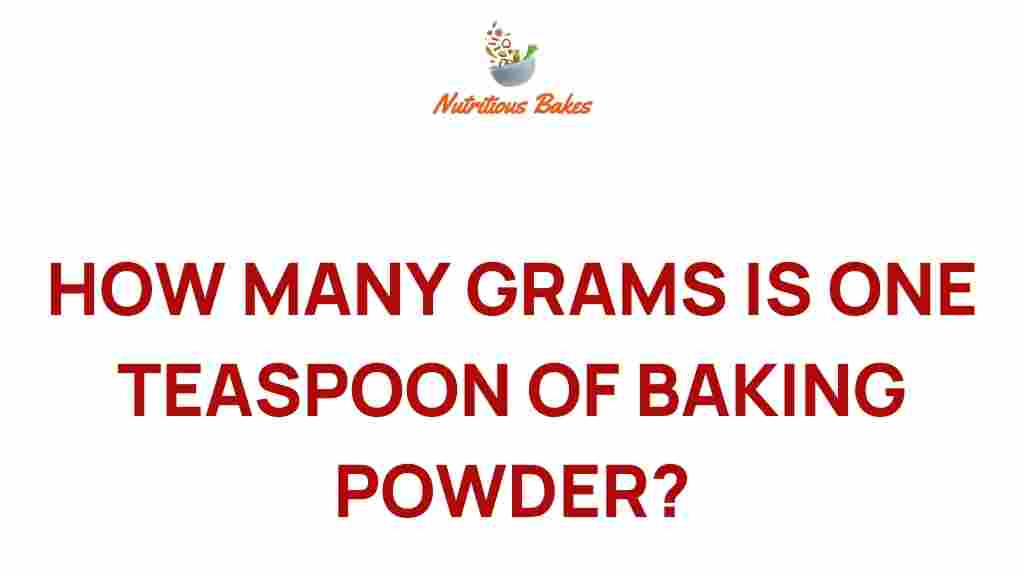The Surprising Weight of Baking Powder: How Many Grams in a Teaspoon?
Baking powder is an essential ingredient in many recipes, especially in baking. Understanding its weight and how to measure it accurately can significantly affect your cooking and baking results. In this article, we will explore the weight of baking powder, how many grams are in a teaspoon, and why precise measurement is crucial for recipe accuracy.
What is Baking Powder?
Baking powder is a leavening agent used in baking to help dough rise. It typically contains a combination of an acid, a base, and a filler like cornstarch. When baking powder is moistened and heated, it produces carbon dioxide gas, causing the dough to expand and become light and fluffy.
The Importance of Accurate Measurement
When it comes to baking, precision is key. A small variation in the amount of baking powder can lead to major differences in texture, flavor, and overall success of your baked goods. This is where understanding teaspoon measurement becomes vital.
How Many Grams Are in a Teaspoon of Baking Powder?
The standard conversion for baking powder is that one teaspoon of baking powder weighs approximately 4.6 grams. This can vary slightly depending on factors such as humidity and how the baking powder is packed. For precise culinary results, it’s best to use a digital scale whenever possible.
Measuring Baking Powder Accurately
To measure baking powder accurately, follow these steps:
- Use a clean, dry teaspoon.
- Open the baking powder container and stir the powder to aerate it.
- Dip the teaspoon into the baking powder container.
- Gently level off the baking powder with a straight edge, such as a knife.
- Avoid scooping directly from the container, as this can pack the powder and lead to an inaccurate measurement.
Cooking Tips for Using Baking Powder
Here are some cooking tips to keep in mind when working with baking powder:
- Check Expiration Date: Baking powder loses its potency over time. Always check the expiration date before use.
- Store Properly: Keep baking powder in a cool, dry place to maintain its effectiveness.
- Use Right Away: Once mixed into your batter, bake immediately to take advantage of its leavening properties.
Understanding Baking Science
Baking is as much a science as it is an art. The science behind baking powder involves understanding the chemical reactions that take place during the baking process. When baking powder is combined with liquid, it activates, producing carbon dioxide gas. This gas creates bubbles that expand when heated, causing the batter to rise.
It’s important to note that there are two types of baking powder: single-acting and double-acting.
- Single-acting baking powder: Requires moisture to activate. It should be baked immediately after mixing.
- Double-acting baking powder: Contains two acids and reacts in two phases—once when wet and again when heated. This gives you more flexibility in timing.
Ingredient Conversion for Recipe Accuracy
When following a recipe, especially one from a different country, you may encounter different measurement systems. Understanding ingredient conversion is crucial for recipe accuracy. Here’s a quick reference for baking powder:
- 1 teaspoon of baking powder = 4.6 grams
- 1 tablespoon of baking powder = 13.8 grams (which is about 3 teaspoons)
- 1 cup of baking powder = 192 grams
Troubleshooting Common Baking Powder Issues
If your baked goods are not turning out as expected, here are some troubleshooting tips:
- Flat Cakes: If your cakes are flat, you may not have used enough baking powder or it may be expired.
- Overly Dense Products: Too much baking powder can lead to a dense texture. Remember that a little goes a long way!
- Uneven Rising: Ensure thorough mixing of your batter to distribute the baking powder evenly.
Additional Tips for Culinary Precision
Achieving culinary precision in baking can elevate your results. Here are some additional tips:
- Use a Scale: Whenever possible, measure baking powder and other ingredients by weight for more accuracy.
- Consider Altitude: If you’re baking at high altitudes, you may need to adjust the amount of baking powder used.
- Keep Ingredients Fresh: Use fresh baking powder to ensure maximum leavening power.
Conclusion
Understanding the weight of baking powder and how many grams are in a teaspoon is crucial for recipe accuracy and achieving the best results in your baking endeavors. Remember, baking is a science that requires precision and attention to detail. By utilizing proper measuring techniques and being mindful of the ingredients you use, you can create delicious baked goods that rise perfectly every time.
For more tips on culinary precision and ingredient conversion, check out our cooking tips page. And for further reading on baking science, visit this comprehensive baking guide.
This article is in the category Tips and created by NutritiousBakes Team
